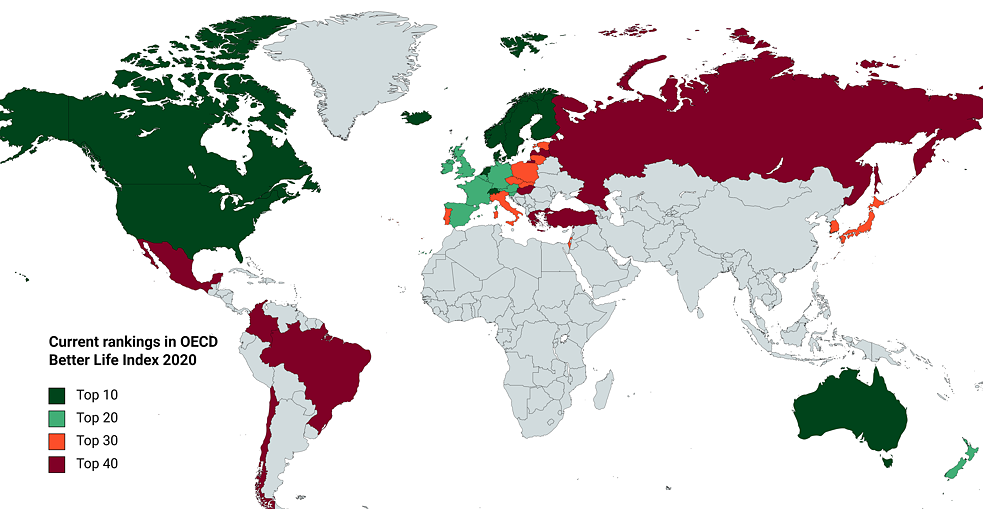The standard indicator of prosperity is currently gross domestic product (GDP). In light of climate change and resource scarcity, it’s time to find a new metric.
Is it the annual vacation, owning a car, and getting a new smartphone every two years? Or is it the big trip, having a second car, and owning a condo? However individuals define prosperity, there is a common denominator for most people in industrialized countries: Prosperity is correlated to ownership. It’s about material security, the feeling of “I am what I have.”No Longer Up to Date
It’s no wonder. The concept of prosperity and its association with material goods is deeply ingrained in industrialized societies. This is already evident in the official indicator used to measure prosperity: gross domestic product (GDP). Since the end of World War II, GDP has been the standard indicator of prosperity. When it rises, we refer to it to as economic growth. When it experiences two consecutive quarters of decline, we refer to it as a recession. However, there is little widespread knowledge about what GDP actually measures: the value of all goods and services produced within a country, specifically those that are final products and not intermediate products for other goods or services. For example, if a forest is clear-cut and an expressway is built in its place, this will have a positive impact on GDP. On the other hand, if the area becomes a nature reserve, providing improved air quality, a recreational space, and a habitat for plants and animals, it doesn’t really affect GDP.In the face of the climate crisis, resource scarcity, inflation, and disrupted supply chains — just to name a few problems — it has become clear that such a one-dimensional index is no longer up to date. This begs the question: What metric or metrics should we be using instead? Which indicators have the potential to accurately reflect sustainable prosperity while remaining clear and useful enough to make it into the evening news?
A Substitute for Meeting Our Needs
Before responding to this question, it’s worth taking a brief detour: an internal dialogue that begins with a simple question. For example, why do I want to have my own house? The dialogue should not come to an end after the first possible answer: Because I want my children to grow up in a green environment. Instead, it is important to inquire further like a four-year-old who seems to only know one word: “Why?” At the end of this chain of questions, in most cases, the following realization emerges: The majority of material possessions that many people surround themselves with — a car, a house, a home theater system with a projector, a pool in the yard — are actually substitutes. Substitutes for meeting our needs. Perceptions of well-being and prosperity vary widely and are influenced by a huge number of cultural, personal, political, economic and, increasingly, ecological factors. In order to be able to compare them in an internationally meaningful way, a single macroeconomic indicator has long since ceased to be sufficient.
| © Shutterstock, Collage: Goethe-Institut
Take the example of owning a condominium. In reality, the need is not actually to own a specific apartment, with the possibility of paying it off only when it becomes too large and is no longer accessible in your old age. The need is for a secure roof over your head — independent of rent increases, landlords reclaiming it for personal use, index-linked leases, and a latent fear of losing your job. Take the example of a car. Here, too, there is a need for security, namely the need for mobility on your schedule. The less reliable the bus, the farther the train station, the greater the need for an alternative.
Perceptions of well-being and prosperity vary widely and are influenced by a huge number of cultural, personal, political, economic and, increasingly, ecological factors. In order to be able to compare them in an internationally meaningful way, a single macroeconomic indicator has long since ceased to be sufficient.
| © Shutterstock, Collage: Goethe-Institut
Take the example of owning a condominium. In reality, the need is not actually to own a specific apartment, with the possibility of paying it off only when it becomes too large and is no longer accessible in your old age. The need is for a secure roof over your head — independent of rent increases, landlords reclaiming it for personal use, index-linked leases, and a latent fear of losing your job. Take the example of a car. Here, too, there is a need for security, namely the need for mobility on your schedule. The less reliable the bus, the farther the train station, the greater the need for an alternative. The necessity for an alternative measurement of prosperity arises from two demands. First, it is necessary to make the value of sustainability quantifiable and tangible to determine whether a society is on a reasonably sustainable path. Second, an alternative could recognize and address the needs of the people through political means — from well-equipped local public transport to affordable housing and the ability for all people to actively participate in society to an environment that is as intact as possible.
The Individual Understanding of Prosperity
There are several indices with a sustainable component that already offer alternative perspectives. They are called the Better Life Index, Environmental Performance Index, Happy Planet Index, and Planetary pressures-adjusted Human Development Index. They measure a variety of factors, from the life satisfaction of a population to the ecological footprint, from carbon dioxide emissions to social cohesion. These indices enable rankings that allow countries to be compared, and over time, they also track the development within a country. However, the effects of advertising on a country’s image cannot be ruled out — as illustrated by Scandinavian countries’ consistently good performance in the Better Life Index and Costa Rica’s number one ranking in the Happy Planet Index for the fourth time in a row. Results worth discussing: The result of the Better Life Index of 2020
| © Radom1967, CC BY-SA 4.0
Results worth discussing: The result of the Better Life Index of 2020
| © Radom1967, CC BY-SA 4.0 In their utilitarian tradition, the alternative indices are certainly not perfect, but they represent a first step towards a new index — an index that demonstrates that prosperity encompasses much more than material security. This index measures and reflects other values, such as health, clean air, easily accessible education for all age groups, opportunities for social participation, inclusion, and mitigating climate change. Through this process, the individual understanding of prosperity will also evolve towards a good and sustainable life.
09/2023
